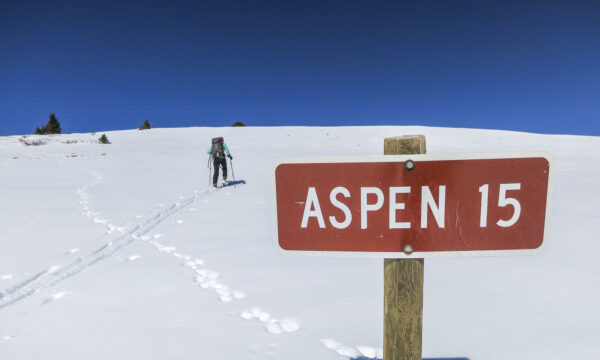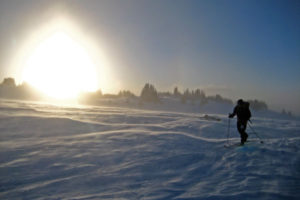Fun tour ideas to prepare for the annual race

At midnight on April 3, as many as 200 teams of two will ski off into the night for the 24th Elk Mountain Grand Traverse.
The annual backcountry ski race from Crested Butte to Aspen covers 40 miles and crosses two mountain passes, climbing 7,000 vertical feet along the way. If you have this event on your calendar, it’s time to start thinking about training.
It’s an incredible experience. Connecting two classic mountain towns in this fashion, skiing through the night with a partner — it’s bucket-list worthy.
It should also be said that it’s an arduous effort, even for those most-prepared and in the best of conditions. So it’s critical you get enough miles and vertical under your belt, or you’re going to be in for a long night (and following day) out there.
I know the race well. My wife and I have finished the Grand Traverse 15 times, nine together as a co-ed team. We’ve had some good races, some great races, and some rough ones. We’ve won the overall co-ed division on two occasions and stood elsewhere on the podium several other times. Our fastest year was 9 hours, 29 minutes, and we’ve had no DNFs.
There are various things you can do to prepare. Uphill training is obviously a requirement. Scouting the route is also a good idea. But none is more important than getting out with your partner for some full-day, high-mileage efforts.
The longer outings provide much more than just time on your feet. They allow you to get in sync with your partner, their pacing, mindset, etc. They also help you fine-tune your systems of packing, hydration, food, and layering. And you can test the limits of your equipment in different conditions, from your skins to your clothing.

In a general sense, the long days are more fun and adventurous than simply doing a lot of ski area skinning.
We find ourselves repeating a handful of local tours for training each year. They’re fun, they provide mileage, vertical, and – in some cases – a good preview of sections of the course. Use these tours as a source of training ideas for your own Grand Traverse preparation.
Express Creek to Richmond Ridge
Start at the ghost town of Ashcroft and head up Express Creek Road to Richmond Ridge. Follow the Richmond Ridge road north, past Barnard Hut to the Sundeck, and down to Aspen. The distance covered is about 20 miles, the vertical gain is around 4,000 feet.
This tour is a classic Grand Traverse training day that all racers should plan to do at least once before race day. It has a good amount of mileage and vertical, but the real benefit is in the recon it provides.
The Richmond Ridge to Sundeck section isn’t the most technical. But when you reach this point on race day, you’ll be exhausted from the 25 miles you covered to get here. So it’s an enormous benefit to see the layout of climbs and descents in advance, so you know the right time to put on skins or pull them off to ski.
It can feel like a serious blow to your mental game to come around a corner and see another unexpected climb during the race. So make sure you try to do this tour once beforehand.

Hunter Creek/Lenado to McNamara and Margy’s
It’s pretty convenient to have such a well-developed hut system around Aspen, and the routes to and from these huts are a great way to train. They’re booked most nights, so many of the routes are often packed down and straightforward to follow. The trail is also marked periodically with blue diamonds, which further aids navigation.
McNamara and Margy’s are our favorite local huts to integrate into a long training day. You can use the high Hunter Creek Trailhead or Lenado as a starting point. You can do an out-and-back up to one of these huts, or – for a more extended day – you can connect them both.
Consider this as one option: From Hunter Creek, head up to McNamara Hut. Continue along the backcountry route down to Woody Creek. Locate Spruce Creek and take that to Sawmill Park, and then continue to Margy’s Hut. Descend the standard route from Margy’s Hut back down to Lenado. When you reach the cabins of Lenado, locate the Tinpot Trail and follow it up to Four Corners. Descend from Four Corners back to the Hunter Creek trailhead. The distance of this tour is about 25 miles. The vertical gain is around 5,500 feet.

Harry Gates / Peter Estin huts loop
You can design similar training missions around the Harry Gates and Peter Estin huts up above Ruedi Reservoir. From Thomasville, you can go up the Montgomery Flats route to the Gates Hut and descend to the Spring Creek trailhead, covering 14-15 miles. You can add an out-and-back to the Peter Estin Hut for an additional 12 miles.
If you end up finishing in the darkness, maybe that’s ok. The Grand Traverse starts at midnight, and you’ll spend the first seven hours of the race in the dark, skiing by headlamp. So a little night training could be helpful.
Star Peak Loop
If you’re looking for more challenge, consider a circumnavigation of Star Peak. This suggestion is for those who are fit, fast, and comfortable breaking trail all day. It’s less traveled, tougher to navigate, and it requires a higher level of backcountry ski experience than the other suggestions. For the best chance of success, wait for a clear, calm day with good avalanche stability later in the spring.
From Ashcroft, head up towards Tagert and Green-Wilson huts, and continue to Pearl Pass. Descend from Pearl Pass towards the Friends Hut. At this point, you will be joining the actual Grand Traverse course. Climb up to Star Pass from the Friends Hut. Once at the pass, take in the view and acknowledge that you are at the halfway point of the race course.

From Star Pass, continue along the race route to Taylor Pass, and descend Express Creek Road back to Ashcroft. The total distance is about 20 miles with a considerable vertical gain.
These are just a few training options that are a little more creative than simply skinning around Ajax, Highlands, Snowmass and Tiehack. Now, if all you want are easy miles and a lot of uphill, then I recommend you just do sections of the Power of Four course.
If you’re new to endurance events, let me share one little nugget of wisdom: the race itself isn’t always that much fun. Take advantage of the training days, they’re often more enjoyable than the event itself. Being out on the trails, with a friend or partner, maybe exploring a new area, preparing for a big goal out on the horizon— take advantage of the training days, make it fun.
I should add that additional homework and planning are required for a safe and successful outing. These are true backcountry ski tours and should be treated as such. Solid partners, navigation skills, avalanche terrain awareness and equipment, and emergency plans are all required. Use this information as a source of ideas, and do your own homework to ensure a safe and successful day.
Use your Grand Traverse preparation as an opportunity to explore some new areas in your backyard. It will help you out on race day, and you might find that the training outings are often the most fun part of it all.











Leave a Reply